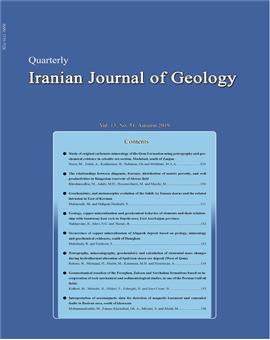The relationships between diagensis, fracture, distribution of matrix porosity, and well productivities in Bangestan reservoir of Ahwaz field
Subject Areas :Mehdi Khoshnoodkia 1 , محمد حسين آدابي 2 , Mahboubeh Hooseni-barzi 3 , Mehdi Khoshnoodkia 4
1 -
2 -
3 -
4 -
Keywords: Diagensis Fracture Well production Ahwaz Bangestan,
Abstract :
Ahwaz Bangestan reservoir (Ilam and Sarvak formations with approximately 1000 meter thickness) were deposited in the Upper Cretaceous period, which is deposited in different sedimentological and tectonic situations. Ahwaz Bangestan reservoir is divided into four reservoir zones (C-E-G-I) which are separated by zones of dense limestone (A-B-D-F-H). This reservoir is formed due to repeating shallowing upward of shoal-bar to lagoonal facies with distribution of rudist debris, with the exception of younger sequence which belongs to deeper environment. Back shoal facies show frequent depositional changes in vertical and horizontal directions in zones C3-E-F-G-I, the changes which can be seen in reservoir. Furthermore, the effect of basement faults, with trend nearly N-S in Ahwaz Bangestan reservoir, resulted in changes of ancient paleogeography. These changes had an important effect on diagentic changes, depositional setting, and finally productivity in conventional and carbonate fractured reservoirs. Matrix porosity is fabric selective in zones C3-E-G-and I. So, grainstone, and packstone facies have better reservoir quality than wackestone and mudstone facies. Diagensis and meteoric waters affected the top of every exposure cycles, and caused the best reservoir quality in grainstone, and packstone facies and productivity of wells. But, zone C1 of Ahwaz Bangestan reservoir (chalky limestone) experienced dominantly solution and leaching, which caused an increase in matrix porosity, but little changes in permeability. Furthermore, the open fractures developed in zones E, F and G which are located in the central and southern parts of the field. Existence of open fractures are confirmed by mud losses, analysis of sedimentary structure and dynamic reservoir data. Increase of mud losses in some area of limestone zones (D, F, and H) could be an indication of vertical relationship of two reservoirs and absence of sedimentological barrier in these areas.
ارزانی، ع. و حیدری، خ.، 1387. تحلیل ساختاری میدان نفتی اهواز با نگرش ویژه بر شکستگیهای آن، شرکت ملی مناطق نفت¬خیز جنوب، گزارش داخلی شماره پ-6397.
بررسی کیفیت مخزنی بنگستان ميدان اهواز، 13۹۴. شرکت ملی مناطق نفت¬خیز جنوب. گزارش داخلی شماره پ-۸۰۷۹ .
Berberian, M., 1995. Master blind thrust faults hidden under the Zagros folds: Active Basement Tectonics and Surface Morphotectonics. Tectonophysics, 241, 193-224.
Bolz, 1978. Core study in Bangestan reservoir of the Ahwaz field, Oil Service Company of Iran, interior published report No. 1276.
Falcon, N.L., 1961. Major earth-flexing in the Zagros Mountains of southwest Iran. Quarterly journal of the Geological Society of London, 117, 367-376.
James, G.A. and Wynd, J.G., 1965. Stratigraphic nomenclature of Iranian oil consortium agreement area. American Association of Petroleum Geologists, Bulletin 49, 2182-2245.
Mc Quillan, H., Twerenbold, E. F., Sangree, J. B. and Masson, P. H., 1961; Asmari Fracture Study. IOEPC, 104-742.
Navabpour, P., Angelier, J. and Barrier, E., 2010. Mesozoic Extensional brittle tectonics of Arabian passive Margin inverted in zagros collision, (Iran, Interor Fars)Geological society London.
Saadallah, N., Roustaie, M., Salehi, M. A., Najafzadeh, K., Edalat. A. and Shojaee, S., 2019. Mansoorabad PSTM/PSDM 3D Seismic Interpretation Structural Modeling and Velocity Modeling Report. (Interior report NISOC), 240.
Sherkati, S., Molinaro, M., Frizon De Lamotte, D. and Letouzey, J., 2005. Detachment folding in the Central and Eastern Zagros fold-belt (Iran): salt mobility, multiple detachments and late basement control. Journal of Structural Geology, 27, 1680-1696.
Speers and Baker 1978. Ahwaz Bangestan reservoirs relationship between fracture distribution matrix porosity and well productions, Oil Service Company of Iran, interior published report No: 3458.


